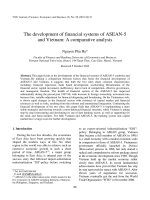History - fundamental - development of MRI system
Bạn đang xem bản rút gọn của tài liệu. Xem và tải ngay bản đầy đủ của tài liệu tại đây (1.6 MB, 25 trang )
DR. NGUYEN XUAN THUC
MRI History
Damadian created the world's first magnetic
resonance imaging machine in 1972
Damadian, along with Larry Minkoff and
Michael Goldsmith, performed the first MRI
body scan of a human being on July 3, 1977
Paul Christian Lauterbur shared the Nobel Prize in
Physiology in 2003 with Peter Mansfield for his work
which made the development of magnetic resonance
imaging (MRI) possible (researched from 1963 until
1985).
The magnet ss the most important component of the MRI
scanner
The magnet currently used are in the 0.2 to 3.0-tesla
range (2,000 to 30,000-gauss).
Higher values are used for research
Earth magnetic field : 0,5-gauss
There are three types of magnets used in MRI systems:
-
Resistive magnets : no more used
-
Permanent magnets: 0.2 to 1.0-tesla
-
Super conducting magnets: 1.0 to 3.0-tesla
Magnetic field
The lower field strengths can be achieved with
permanent magnets, which are often used in "open"
MRI scanners
Higher field strengths can be achieved only with
superconducting magnets
The atom that MRI uses is the hydrogen atom
Fundamentals
The patient is placed in the magnet bore, radio
waves are passed through the body in
particular sequences. The body tissues
respond by emitting the pulses, which are then
recorded by a detector then sent to computer
Fundamentals
Various body tissues emit characteristic MR
signals, which determine whether they will
appear white, grey or black on the images.
In general: Water is black on T1-WI, white on
T2-WI. Most tumors and inflammatory
masses appear white on T2-WI. Compact
bone appears black in all sequences
-
T1WI - BOLD images
-
T2WI - MRA
-
PDWI - MRV
-
DWI - Post-Gd images
-
ADC - Volumetric images
-
GE - FLAIR
-
Perfusion images - STIR
-
f MRI - Etc…
T1W T2W
Fluid signal ↓ Fluid signal ↑
Signal of Lipid ↑ Signal of Lipid ↑
T1W (+-FS) + CE T2W – FS (STIR)
T1W T2W
T1W
T1W
+ CE
T2W
T2W T2W-FS
Advantages
- Greater differentiation of soft
tissue structures
- Can be acquired in any planes
- Can provide vascular study without
use of IV contrast
Disadvantages
- Longer time of scanning
- Motion artifacts from respiration,
cardiac pulsation
Generally, MRI is very safe and adverse reactions to
contrast agent (gadolinium) are extremely rare.
Absolute contraindications:
Cardiac pacemakers, implanted cardiac
defibrilations, otic/inner ear/ cochlear implantsm
metal fragments in the eye.
Others:
- Heart valve, aneurysm clip (depending on the
models), passive implants (depending on its
ferromagnetic status)
- Pregnancy : No known risks, how ever . . .
MRI ACCIDENTS
MRI ACCIDENTS
in Brain Tumors
Differential diagnosis of ring-enhancing brain lesions:
Neoplasm :
.Primary neoplasm (high-grade glioma, meningioma, lymphoma,
acoustic schwannoma, cranio-pharyngioma).
.Metastatic tumor
Abscess
.Bacterial, fungal, parasitic abscess.
.Empyema (epidural, subdural, orintraventricular)
Hemorrhagic-ischemic lesion
• Resolving infarction
• Aging hematoma
Demyelinating disorder
Radiation necrosis
Cyst with enhancing mural nodule
1.Pilocytic astrocytoma
2.Hemangioblastoma
3.Pleomorphic xanthoastrocytoma
4.Ganglioglioma
Patterns of Contrast Enhancement
in Brain Tumors
Low-grade diffuse astrocytoma
(WHO grade II).
This 44-year-old woman presented
with an epileptic seizure









